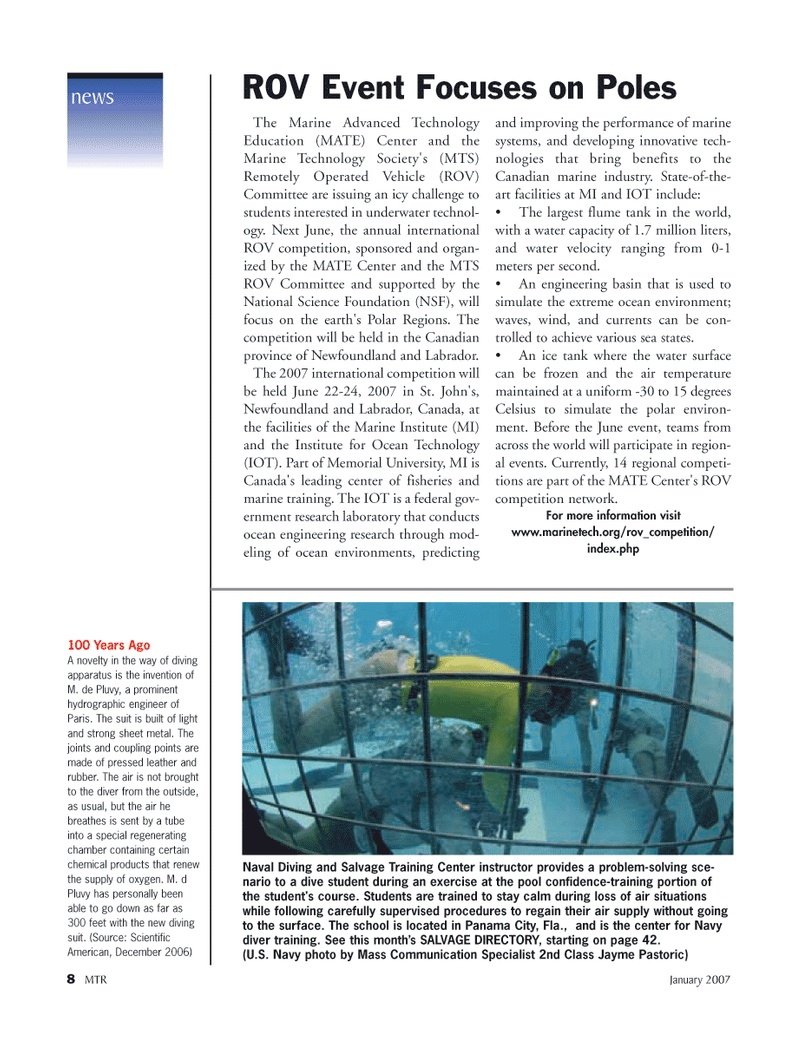
Page 8: of Marine Technology Magazine (January 2007)
Seafloor Engineering
Read this page in Pdf, Flash or Html5 edition of January 2007 Marine Technology Magazine
8 MTR January 2007
The Marine Advanced Technology
Education (MATE) Center and the
Marine Technology Society's (MTS)
Remotely Operated Vehicle (ROV)
Committee are issuing an icy challenge to students interested in underwater technol- ogy. Next June, the annual international
ROV competition, sponsored and organ- ized by the MATE Center and the MTS
ROV Committee and supported by the
National Science Foundation (NSF), will focus on the earth's Polar Regions. The competition will be held in the Canadian province of Newfoundland and Labrador.
The 2007 international competition will be held June 22-24, 2007 in St. John's,
Newfoundland and Labrador, Canada, at the facilities of the Marine Institute (MI) and the Institute for Ocean Technology (IOT). Part of Memorial University, MI is
Canada's leading center of fisheries and marine training. The IOT is a federal gov- ernment research laboratory that conducts ocean engineering research through mod- eling of ocean environments, predicting and improving the performance of marine systems, and developing innovative tech- nologies that bring benefits to the
Canadian marine industry. State-of-the- art facilities at MI and IOT include: • The largest flume tank in the world, with a water capacity of 1.7 million liters, and water velocity ranging from 0-1 meters per second. An engineering basin that is used to simulate the extreme ocean environment; waves, wind, and currents can be con- trolled to achieve various sea states. An ice tank where the water surface can be frozen and the air temperature maintained at a uniform -30 to 15 degrees
Celsius to simulate the polar environ- ment. Before the June event, teams from across the world will participate in region- al events. Currently, 14 regional competi- tions are part of the MATE Center's ROV competition network.
For more information visit www.marinetech.org/rov_competition/ index.php news
ROV Event Focuses on Poles
Naval Diving and Salvage Training Center instructor provides a problem-solving sce- nario to a dive student during an exercise at the pool confidence-training portion of the student's course. Students are trained to stay calm during loss of air situations while following carefully supervised procedures to regain their air supply without going to the surface. The school is located in Panama City, Fla., and is the center for Navy diver training. See this month’s SALVAGE DIRECTORY, starting on page 42. (U.S. Navy photo by Mass Communication Specialist 2nd Class Jayme Pastoric) 100 Years Ago
A novelty in the way of diving apparatus is the invention of
M. de Pluvy, a prominent hydrographic engineer of
Paris. The suit is built of light and strong sheet metal. The joints and coupling points are made of pressed leather and rubber. The air is not brought to the diver from the outside, as usual, but the air he breathes is sent by a tube into a special regenerating chamber containing certain chemical products that renew the supply of oxygen. M. d
Pluvy has personally been able to go down as far as 300 feet with the new diving suit. (Source: Scientific
American, December 2006)
MTR#1 (1-16).qxd 1/11/2007 4:19 PM Page 10

 7
7

 9
9
